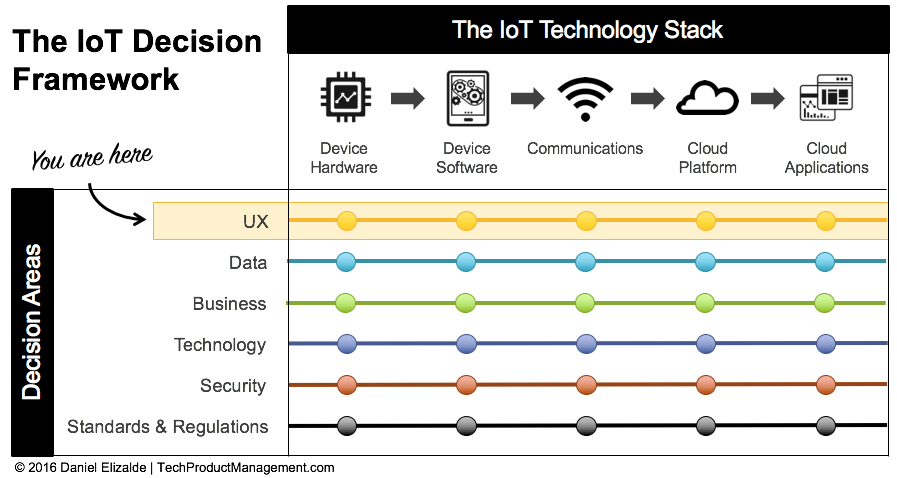
Throughout the years, UX practices have evolved and adapted to the latest technology trends, from the desktop application era, to the web revolution, to the mobile revolution.
But now, product and design teams face a new UX challenge, one that might be bigger than all the previous ones combined: the IoT revolution.
As this new era of technology continues to gain momentum and infiltrate all industries, one of the biggest challenges IoT product teams face is how to provide a consistent user experience across the entire IoT Technology Stack.
So why is creating an IoT experience more complicated than creating a traditional Cloud or mobile experience? The IoT Decision Framework shows IoT products simply have more parts to consider.

Why creating a consistent IoT user experience is hard
Most Product Managers entering the IoT space usually have experience managing either hardware or software products. But IoT products include both software and hardware, bringing new challenges that most PMs are not familiar with.
From a product development perspective, hardware and software are likely to be developed and managed by different teams. But keep in mind that users don’t really care who’s building what. They expect a cohesive experience across every touchpoint of your product, regardless of whether it’s software or hardware.
Let’s look at a couple of real-world examples to show the complexities of delivering a cohesive IoT experience.
Exhibit A: UX challenges in consumer IoT products
Think of a smart thermostat. Although this is a relatively simple product, it provides several user experience elements that pure software products don’t have.
First of all, there’s a physical device. And that device needs to be visually appealing. Otherwise, your customer won’t be willing to install it on the wall in the middle of their living room. This is a challenge that industrial designers are very familiar with, but if you are a new IoT PM coming from a software background, this might be new terrain for you.
Next, the device itself provides a user interface to enable the user to set the temperature, display the time, etc. Right there, you have a second experience that you need to create. The user interface for your device needs to be intuitive and attractive, and it needs to fit in a small space.
As you work with your team to craft the user experience at the device level, you’ll need to decide whether to have a simple display, physical buttons, LCD screen with a touch interface, etc. Not only does it need to be easy to use and fully functional, but it also needs to be aesthetically pleasing and on-brand.
In addition to the physical user interfaces, connected devices usually have web interfaces that address different use cases. For example, a smart thermostat is likely to have a web dashboard to provide detailed information about usage patterns or energy consumption. And it might have a mobile application to provide summary information and remote control on the go.
These form factors provide you with different levels of real estate to display information, so it’s important to understand the user’s mental model (what they are looking to accomplish) when interacting with each of these user interfaces.
All these different experiences need to be consistent with each other. Although the user is interacting with the thermostat through three different user interfaces (the thermostat, desktop, and mobile), your goal is to ensure that she feels like she is interacting with the exact same product, her thermostat, and not three different products.
Exhibit B: UX challenges in Industrial IoT products
Industrial products have even more challenges when it comes to user experience. Let’s use solar panels as an example. Imagine an array of solar panels installed on the roof of a commercial building. All the panels might be connected to a centralized hub or gateway to aggregate the signals coming from each panel.
This gateway might not need to be as good-looking as the smart thermostat. After all, it will be installed on the roof of a building. But on the other hand, it needs to be rugged and waterproof since it’ll be installed outdoors. Other design considerations include how technicians will interact with the gateway. Does it need an LCD display, or should it only have a couple of LED lights to show it is working properly? Those are design decisions you’ll need to make.
Just like the smart thermostat, the product probably has a web dashboard for the facility manager to monitor performance, and it may have a tablet app for technicians to troubleshoot things in the field.
In addition to these interfaces, the gateway might need to connect to the building management system via a direct cable connection or via an API accessible directly from the gateway. Though it might not be obvious, APIs and connectivity points are user interfaces for which you need to develop and craft a good experience. These connections will be used by developers and system integrators who will form an impression of your product based on the interface you provide.
For them, it doesn’t matter if your end customer dashboard is very polished. If the interface they are using is not equally polished, they’ll have a bad user experience and will rate your product poorly.
Let’s recap. In this commercial solar panel product, not only do you have multiple software and hardware interfaces, you also have four users to please: the technician, the facility manager, the developer, and the systems integrator.
So how do you ensure consistency of experience across your product?
What makes IoT products complicated is that now you have to address usability across the full IoT Technology Stack and likely across multiple users.
Plus, building an IoT product is a big undertaking, and it’s very common to have multiple teams involved throughout the development lifecycle. Most likely, you’ll interact with other Product Managers, and there will be different Engineering teams responsible for developing different parts of the IoT Technology Stack. If that’s not enough, you’ll also have input from Sales, Marketing, Customer Success, etc.
So as a Product Manager, what can you do to address these challenges? In a nutshell, you need to be the source of alignment between everybody involved. You need to have a deep understanding of all of your users and be a communication hub between every team within your company.
Note: If you want to accelerate your learning, in my online program, The IoT Product Manager, you’ll learn a step-by-step framework for identifying and prioritizing users and their needs across the IoT Technology Stack.
The Bottom Line
It is our role as Product Managers to ensure all teams are aligned behind the product vision and to make sure everybody understands who your users are, how you are prioritizing features for each of them, and what user experience you want to provide to them. Only after you have this alignment can you start thinking about execution (IoT roadmaps, backlogs, development, etc.).
2 Comments
-
It would be interesting to have sharing of boundary / interface requirements between product managers across the decision framework. Creating visibility of the impact between individual tiers of the IoT decision framework and then ensuring co-creation across the decision framework should help in providing shared responsibility and accountability!
-
Very good point Vikram. I agree. Also, using the IoT decision framework as a common language between teams can help simplify those conversations and get to an agreement sooner than if different groups had their own way of referring to things.
-Daniel
-